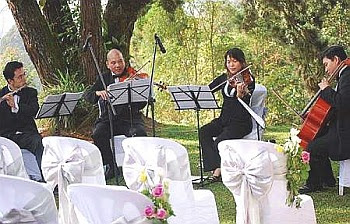Monday July 30, 2007
Over a Cuppa: By Hoo Ban Kee
Cameron Highlands is still an attractive tourist resort despite the warmer climate.
I was at the Bharat Tea House in Cameron Highlands having my brunch when a little sparrow joined me, very briefly, at my table. While keeping a distance, she tilted her head and looked at me, as if to greet me and ask how I was enjoying my short holiday at the hill resort.
As I momentarily took my eyes off the verdant tea plantation hugging the hill slopes to give my uninvited guest a smile and say, “What a wonderful day!”, she hopped off to join her other feathery friends on the floor.
I suppose it’s only in Cameron Highlands – and a few other places – that you can have such a pleasant encounter with nature, despite the rapid development taking place there.

The Bharat Tea House, located just a few kilometres before Tanah Rata, is a favourite stopover for visitors who like to sip fragrant tea and feast their eyes on the abundant greenery.
Overlooking an expansive tea plantation on rolling hills, it offers a panoramic view of the resort, especially in the morning, when it is bathed in glorious sunlight.
Of course, for those who must have scones with their tea, the teahouse is the right place to be. And business must be good, for Bharat Plantations has set up a similar teahouse near Kampung Rajah for visitors driving up via the new approach road from Simpang Pulai, near Ipoh.
Cameron Highlands has been popular with tourists not only because of its cool weather and restful environment but also its unique colonial ambience. My first visit there was about 40 years ago. It was a big deal then to join an overnight tour as accessibility was still difficult.
Later, when Brinchang was officially opened, I went there again, this time with my young family.
The one-street town then served as a transit point for the convoy of lorries ferrying vegetables and other farm produce to Ipoh and Kuala Lumpur.
So much has changed since then. Apparently Ringlet, Tanah Rata and Brinchang have become prosperous; they have expanded and now boast luxury hotels and high-rise apartments – thanks to tourism development.
But the most noticeable change involves the climate. It used to be cold in the day and freezing at night. Last week, even when it rained cats and dogs, the temperature dropped to just 18°C at night.
The noon sun would have been scorching, if not for the breeze. The only people wearing warm clothes were the tourists while the locals were comfortable in tees and short-sleeved shirts.
In the early days, children with rosy cheeks and runny noses used to play along the five-foot ways and open areas. We could easily identify the local people by their rosy cheeks.
Through the years, more of the virgin forests have been cleared to make way for hotel and housing projects as well as large-scale farming. This has inevitably caused the temperature to rise.
My former colleague, Neil Khor, in his book Highland Escapades, noted that Cameron Highlands recorded its lowest temperature, 2°C, in 1935. Walking around under the mid-day sun in Tanah Rata, it wasunthinkable that the mercury could plunge that low even in the days when the British hill station comprised just a few bungalows and farmlands.
I was told that in the early days, local farmers would need a fireplace to warm themselves at night. They would be all wrapped up in thick blankets; even their feet were covered in gunny sacks, to keep off the biting cold.
Cameron Highlands was developed in the 1900s and it was only in 1904 that a bridle path was cut, stretching some 55km from Tapah to the plateau of what is now Cameron Highlands.
It served as a sanatorium, a sort of health and pleasure resort, for British colonial officers and European expatriates serving or working in the peninsula then. In 1926, a development committee was set up for the planning and development of the resort.
Ringlet, Tanah Rata and Brinjang are the three main townships, but Kampung Rajah and Blue Valley show potential as growth centres with the opening of the Simpang Pulai approach road, which caters to visitors from the north.
Despite its hotter climate, Cameron Highlands is still quite an attractive tourist resort, as evidenced by the construction of new hotels and mushrooming holiday apartments.
New shops and restaurants have sprung up, offering a wide assortment of food. One little outlet even advertised Arabian food; unfortunately, it was closed for business the day I decided to be a bit more adventurous.
We tried out a steamboat dinner that offered nine types of vegetables, with chicken, seafood and beef thrown in. Not a bad deal, considering that they charged only RM13 per head.
Once upon a time, strawberries, though planted in Cameron Highlands, were precious as few farmers went into that business. Now, strawberry farms are everywhere; some even allow visitors the novelty of plucking those fruits.
It is quite amusing to see not only fresh strawberries on sale, but various strawberry products such as chocolate strawberries, strawberry ice cream and preserved strawberries.
There are also handbags, purses, key chains and clothing with strawberry motifs, not to mention the famous Strawberry Park Hotel, as well as strawberry soap. It is as if they have gone strawberry crazy in this thriving holiday resort. -- The Star Lifestyle.




